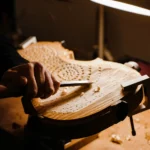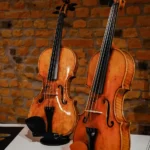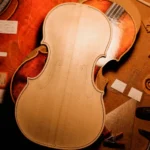The Truly Stradivarius: What are the characteristics of Stradivarius Violins?
Back to BlogThe Truly Stradivarius Characteristics
There have been numerous types of violins throughout history. However, when it comes to Stradivarius violins, there’s hardly a questioning tone to be heard when people refer to the superior qualities these instruments share over all others. A Stradivarius is almost a synonym for quality, but why?
Who Was Antonio Stradivari?
Antonio Stradivari was a noble Cremonese citizen, and despite not coming from a luthier family, he started his apprenticeship at a young age, supposedly with Nicola Amati. He started out with the violin, following Amati’s style, but soon he developed his own style, creating his finest instruments. Little by little, he built his reputation by selling his instruments to the royal families and notable citizens of that time. The tone, responsiveness, elegance of design, visual appeal, and precision of Stradivari crafts were higher than any other at the time.
The Four Distinct Periods of Stradivari’s Work
His life can be divided into 4 periods:
- The Amatisé: 1660 – 1690
- The Long Pattern: 1690 – 1700
- The Golden Period: 1700 – 1720
- The Late Period: 1720 – 1737
From 1700 – 1725, Stradivari hit the peak of his violin-making career (The Golden Period). It was at this time that he distanced himself from the long pattern violin and returned to the standard, smaller-sized instrument.
Although not technically beginning until 1700, some of Stradivari’s earlier work from the 1690s mirrored the quality of those crafted in his golden years. Somewhat controversially, many of these instruments actually had their original labels amended to date post-1700 so that they could be sold at an increased value; any instrument crafted during this time was and remains to be held in high esteem, worth millions and ever-increasing in worth.
➡ Want to understand how instrument value is determined today? Read more about how much fine violins cost.
What Makes a Stradivarius Violin Unique?
These instruments are masterpieces, and their characteristics make them very special. It is estimated that the luthier made more than a thousand instruments, some of them may have had the help of his sons to complete the work, however, approximately 650 of Stradivari’s instruments still survive and some can be seen at museums.
The majority of his violins occupy the spotlight, but Antonio Stradivari also built violas and cellos. His cellos, which are more rare than his violins, are almost all built on a smaller contralto model of about 45cm in length, says Tarisio website.
➡ Learn how collectors and musicians today invest rare Italian violins.
Incredible and unimagined how and with which techniques the maker conquered this. Today, we decided to bring you a few characteristics that differ a Stradivari from any other violin.
The Shape
A Stradivarius violin is distinctive due to its unique shape. Before Stradivari made his violins, violins were commonly rounder and narrower. His violins were often longer with sharper-edged corners and a clear definition between their upper and lower half.
Wood
Instruments of Stradivari have been found to feature unique varieties of wood and varnish. Alpine wood, like spruce and maple wood, was used for the instruments’ various parts.
Varnish
It is normal for many makers to create their own mixture of varnishing to take a particular result. This may have started with these master makers, Stradivari is known for a very unique varnish, scientists have found traces of certain minerals, like copper and aluminum. But no one knows the recipe exactly.
The Craftsmanship
Each Stradivarius is the result of extraordinary craftsmanship—meticulously shaped by hand, with an attention to proportion, arching, and detail that has set the gold standard for violin making.
How Can You Tell If a Violin Is a Real Stradivarius?
Identifying a genuine Stradivarius violin requires careful expertise, as many instruments bear fake labels or were made in his style. Here are key steps experts take to determine authenticity:
The Label Isn’t Enough
While original Stradivari instruments typically bear a label reading “Antonius Stradivarius Cremonensis Faciebat Anno [date]”, many copies also include this, so it cannot be trusted on its own.
Expert Examination of Craftsmanship
Trained luthiers and appraisers look at details such as the scroll carving, purfling, arching, f-holes, and varnish characteristics. Stradivari’s work is highly distinctive, especially from his Golden Period (1700–1720).
Provenance and Documentation
A verified paper trail—including past owners, auction records, and certificates from reputable experts—is often crucial in validating an instrument’s origin.
Scientific Analysis
Techniques like dendrochronology (wood dating), UV and infrared imaging, and CT scanning can help reveal internal structures, materials, and age markers that support or refute authenticity claims.
Appraisal by a Leading Expert
Ultimately, a real Stradivarius must be authenticated by a globally recognized expert or institution, such as Peter Biddulph. Without their verification, a label alone has no market value.
Violinists and musicologists often struggle to distinguish Stradivari’s work from copies and forgeries, as violins labeled “Stradivari” or “in the style of Stradivari” are still being produced to this day. The f-holes are very important to create the sound. Stradivari made some f-holes longer and narrower, his work was somewhat longer in a few periods, with sharper-edged corners and a clear definition between its upper and lower half.
Are All Stradivarius Violins the Same?
A Stradivarius or a Strad is an instrument built by Stradivari, very renowned and known for its superior quality. The Stradivari family were luthiers or makers of stringed musical instruments like violas, cellos, and other violin family members during the 17th and 18th centuries.
The Long Pattern period was characterized by a larger violin, known as a “Long Strad”. Branching out from the standard sizing, Strad’s violins from this time were 12mm longer than the traditional model. It is also worth noting that he might have taken his inspiration from Brescian makers, such as Maggini and Gaspar da Salò, who were known for crafting instruments with a darker, more powerful sound. Many kinds of research and tests have been done in order to find out the luthier secret for such a masterpiece.
Stradivari has been credited with using rare and valuable Alpine spruce for his violins. Some speculate that this wood was unusually dense because it grew in particularly harsh winters when the annual growth rings were near each other.
What we know today is that the Master Maker had deep knowledge in violin-making, and as he improved his financial conditions, he invested in better materials, which resulted in the fine instruments from the Golden Period. He had an understanding of the science behind his work, Stradivari wasn’t just a simple craftsman. Knowing the value of accumulated knowledge of his instruments, he pondered the pros and cons of each instrument, each an improvement on the last.
The Lasting Legacy of Stradivari
Antonio Stradivari’s influence extends far beyond his lifetime. More than 300 years later, his instruments are still considered the benchmark of excellence in violin making. His designs, proportions, and acoustic innovations continue to inspire luthiers around the world—both as models for faithful reproductions and as foundations for modern interpretation.
➡ Curious how modern luthiers replicate these details? See how Luiz Amorim copies Stradivari instruments.
Famous Stradivarius Violins Still Played Today
Many Stradivarius violins have survived in remarkably playable condition—and some of the world’s finest musicians continue to perform with them on major stages. These instruments are not just historical artifacts; they remain living tools of expression, celebrated for their unmatched tone and responsiveness.
The “Soil” Stradivarius (1714) – Known for its rich, dark tone, this violin was famously played by Itzhak Perlman and is considered one of the finest examples of Stradivari’s Golden Period.
The “Gibson ex-Huberman” (1713) – Currently played by Joshua Bell, this instrument has a dramatic history, having been stolen twice and recovered decades later. Its tone is powerful and expressive, perfectly suited for a modern virtuoso.
The “Dolphin” Stradivarius (1714) – Once played by Jascha Heifetz and now in the hands of Ray Chen (on loan from the Nippon Music Foundation), this violin earned its nickname for the shimmering quality of its varnish and tone.
The “Davidov” Stradivarius (1712) – A cello rather than a violin, this instrument was previously played by Jacqueline du Pré and is now used by Yo-Yo Ma. It’s a testament to Stradivari’s mastery across all members of the string family.
These iconic instruments are more than just valuable—they continue to shape how we hear classical music today. Their longevity and relevance are a tribute to the enduring excellence of Antonio Stradivari’s work.
➡ Inspired by Stradivari? Explore the details of this example by Antonio Stradivari, from 1734.
Stradivarius Violins
Stradivari’s instruments continue to shape how we understand violin excellence — not just in sound, but in craftsmanship details. If you’re drawn to this legacy and looking to discover your own exceptional violin, explore our collection of rare Italian violins for sale at Amorim Fine Violins Cremona. From historical treasures to contemporary masterpieces inspired by the Golden Period, we help musicians and collectors connect with truly remarkable instruments.
About the Author and Workshop
This article was produced by the editorial team at Amorim Fine Violins Cremona, a family-run workshop established in 2001 by master luthier Luiz Amorim. With decades of experience crafting, restoring, and authenticating fine violins, the Amorim team serves musicians, collectors, and institutions worldwide. We are committed to ethical expertise, scientific precision, and a passion for preserving musical heritage.









